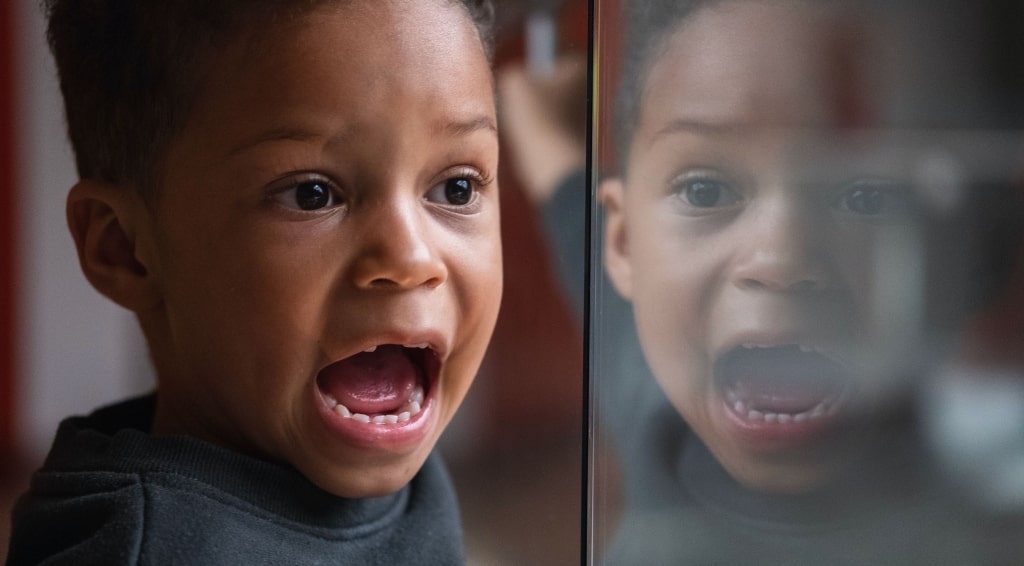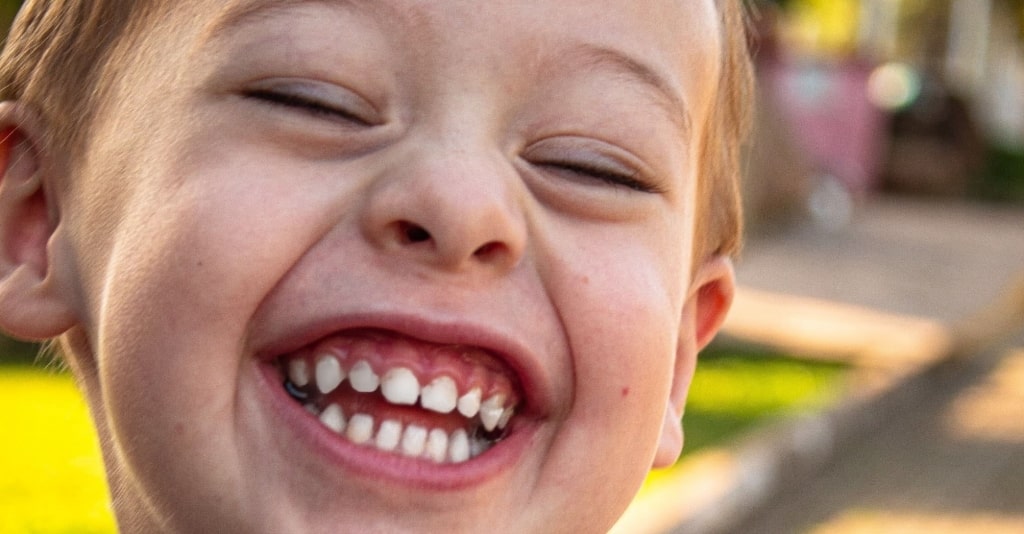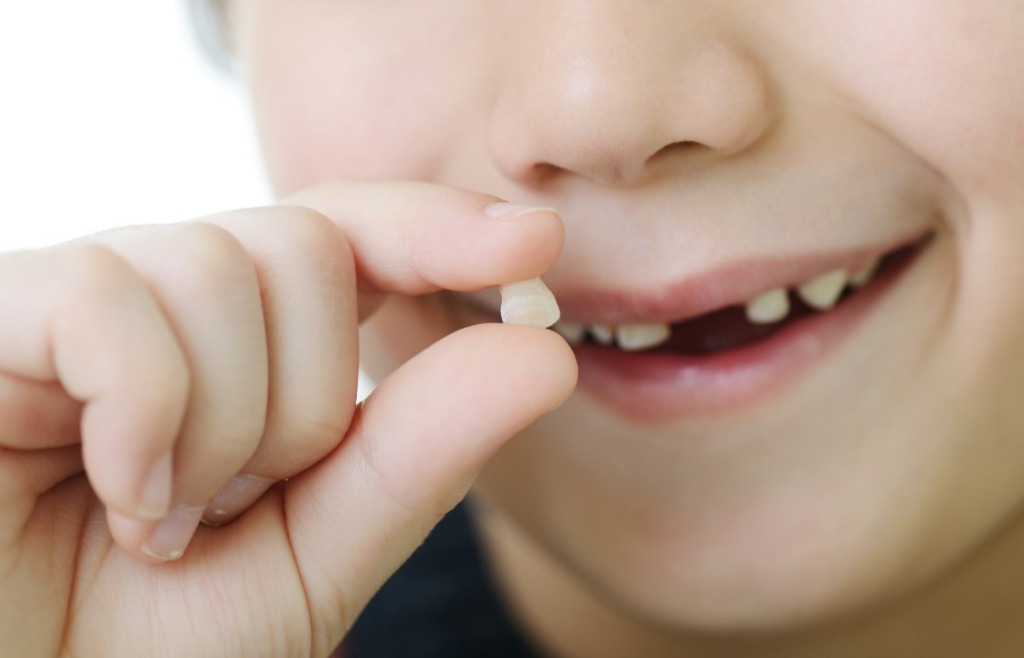what to do with a loose tooth child?
At some point, we've all heard an epic story about the creative ways to pull out a loose babe tooth—whether it'due south from your ain experience as a child, things you've tried on your kids, or some video that has gone viral on YouTube, losing infant teeth is an unavoidable fate that everyone experiences. Because nature will do its affair, at that place is not much we tin can do to avoid our kids from losing teeth. We may as well embrace it and know how to properly handle wiggly baby teeth.
Every bit a parent, if you're prepared and informed about the easiest and near comfortable ways to pull loose babe teeth, y'all'll be able to help your child when the time comes.
In this guide, we'll cover:
- When Practice Kids Start Losing Baby Teeth
- How Many Teeth Do Kids Lose
- In What Lodge Do Baby Teeth Fall Out
- Tips for Relieving Child'south Loose Babe Molar Pains
- Why Do Baby Teeth Get Loose
- How Long Does It Accept for Permanent Teeth to Grow In
- Shark Teeth in Kids
- How to Wiggle Loose Babe Teeth
- Foods That Can Help Babe Teeth Fall Out Faster
- What to Do When Baby Teeth Won't Come Out
When Do Kids Beginning Losing Babe Teeth?
On average, children start to get loose baby teeth effectually age 6. This is just the average though. Some children volition experience their first loose tooth at historic period 4, or even as late equally age 8. Given this large span, there are some means that you lot can predict when your kid volition lose his or her commencement babe tooth.
We can use the timing of when your kid grew in his or her commencement infant molar as a forecast as to when the beginning permanent molar will abound in. The average age for babies to get their first tooth is age vi months. If your baby cut his or her first molar early (effectually three-4 months), chances are high that their beginning permanent molar will grow in early on besides (maybe around age 4-5 years former). If your baby didn't cut his or her kickoff tooth until close to historic period 1, then don't expect permanent teeth to abound in until closer to historic period seven-8.

How Many Teeth Exercise Kids Lose?
All humans take 20 babe teeth and 32 developed teeth. Through babyhood, we lose 20 baby teeth that are replaced by stronger, bigger, and longer permanent teeth. Children lose their offset baby tooth around historic period 6, and the terminal baby teeth fall out around historic period 12-13. The permanent teeth that supervene upon baby teeth are chosen "succedaneous" teeth. The remaining 12 developed teeth (aside from the xx that replaced the baby teeth) are the 1 st , 2 nd , and 3 rd sets of permanent molars. We as well refer to these as the 6-twelvemonth molars, the 12-year molars, and the wisdom teeth. Permanent developed molars grow in into the empty space in the back of our mouths backside where our baby teeth were.
While humans are engineered to have 20 baby teeth and 32 developed teeth, at that place are certain exceptions to the rules. In some instances, our bodies produce fewer than 32 developed teeth. The official term for this is "congenitally missing teeth." If there is a congenitally missing adult tooth, at that place may not exist a permanent tooth to push button out a babe tooth. In this case, the baby molar will stay in place into adulthood. The nigh mutual place this occurs is with the second set of babe molars (the ones farthest in the dorsum).
Family history and genetics is the about influential slice to decide if your child will take congenitally missing teeth. The topic of missing teeth can get a fun Thanksgiving dinner conversation, as you may learn some interesting facts nigh your family unit's tooth history!
In What Order Do Babe Teeth Autumn Out?
For the most part, babe teeth will fall out in the same order that they grew in. The first teeth to get loose are the bottom central incisors (the teeth in the very front). Tooth loss commonly happens in pairs, so when the right primal incisor gets loose, expect the left-side counterpart to follow suit within the upcoming weeks or months. After the bottom central incisors autumn out, next up is usually the top primal incisors or the bottom lateral incisors. The lateral incisors are the 2d molar from the center. A lot of people phone call these "side teeth."
Over the class of almost 2 years (6-8 years of age), expect your child to lose viii teeth. These would be the iv top front teeth (the incisors) and the four lesser front teeth.
In one case all the incisors take fallen out and the permanent developed teeth have started to abound in, the adjacent set of teeth yous tin look your child to lose is going to exist the bottom canines or the beginning set of baby molars. The canines and molars tend to fall out over the course of two or iii years. The final teeth to fall out are well-nigh often the top babe canines or second set of molars.
It is important to note that some children volition lose teeth in a slightly dissimilar order, especially when it comes to canine and molar tooth loss. If this happens to your child, don't fret, as there is lots of variation to the standard textbook charts. If you have a more pressing concern about your kid's pattern and age for losing teeth, yous should bank check in with your child's pediatric dentist .
Tips For Relieving Your Child'due south Loose Infant Molar Pain

Unless your child loses a tooth due to blunt trauma (nosotros hope non!), the fourth dimension it takes for a molar to become loose and so actually fall out is usually a few months. When a baby tooth offset starts to go loose, your child might non even notice and is able to swallow and chew with no complaint. Yet, as teeth get looser and looser, bitter into harder objects—whole apples, corn on the cob, or carrots, for example, may produce mild, or even significant discomfort. This is generally the case for front teeth that get loose. When the baby molars get loose, chewing harder or crunchier foods may be more hard, such as nuts, granola bars, or pretzels.
As the roots of the infant teeth start to resorb (or deliquesce), the edges of the baby molar root go pushed into the gums with repeated chewing and biting. For some children, this can cause localized discomfort. If your child experiences a toothache or soreness with loose baby teeth, the episodes of discomfort are primarily with eating. Try to have your child eat on the other side, and avert difficult, crunchy foods.
Some children will also complain that it hurts to brush loose baby teeth. To exist more than exact, it is not the tooth that hurts, merely the gums surrounding the loose tooth. The localized discomfort associated with sore gums can exist exacerbated due to heavy plaque and poor oral hygiene.
While it is tempting to avoid brushing in areas where teeth are loose, the all-time and fastest way to make the gums feel better is to brush routinely to remove plaque and bacteria that tin can cause gingivitis and mucilage infections. You don't demand to scrub hard. Be gentle, yet thorough.
If your kid is still experiencing hurting with loose baby teeth, information technology is okay to requite over-the-counter hurting medicine (such as Tylenol or Motrin) as a temporary relief.
Why Exercise Baby Teeth Become Loose in the Get-go Place?
Teeth are anchored into the jaw by long roots. The roots of most teeth are 2-3 times longer than the actual tooth itself. Furthermore, some teeth (molars) have multiple roots, which provide for even more anchorage. Here's an interesting fact: top molars have 3 roots, while bottom molars accept ii roots. Incisors and canines only accept one root.
When permanent tooth buds start to abound larger in size, they propel towards the surface. This migration towards the surface puts pressure on the roots of the baby teeth, causing the roots to shorten and resorb. As the permanent molar gets closer and closer to the surface, the root of the baby molar will become shorter, which makes the baby tooth get progressively looser. A baby tooth will simply become loose if a permanent tooth is ready to grow in.
When the time comes for the baby molar to fall out, the root of the babe molar will exist fully resorbed. That is why when the tooth falls out, we never see any remaining root fragments.
The main exception to this dominion is if a molar gets traumatized from a fall or accident. This edgeless force tin crusade the loosening of teeth. Depending on the severity of the injury, often the loose tooth volition tighten dorsum up, or in other instances, the blunt force from trauma may cause the molar to fall out earlier than expected.
How Long Does It Accept for New Permanent Teeth to Grow In?

As noted above, babe teeth get loose and fall out when the permanent tooth is prepare to grow in. In many instances, one time a baby tooth falls out, the permanent molar is already visible at the level of the gums. If the adult molar is visible when the baby tooth falls out, information technology nevertheless may accept 6-12 months for the permanent tooth to fully grow in.
For children whose mouths are very crowded, it can often take over a year for permanent teeth to grow in after the infant tooth falls out. The reason being, most permanent teeth are larger than babe teeth; therefore it can have more time for those larger teeth to push their way through the gums and get oriented into the right position. For children who have insufficient infinite, permanent teeth may grow in crooked or rotated. The more crowded the mouth, the longer it will take for permanent teeth to abound in.
Shark Teeth in Kids
This is non the real, technical term, merely "shark teeth" is the phrase oft used when a permanent molar is growing in while the infant tooth is still in place. The result is rows of teeth, hence the name "shark teeth." The near common area for this to occur is the bottom incisors.
The reason this occurs is due to the position of the permanent tooth existence close to the natural language, while the babe tooth sits farther forward. While it can await a niggling unsettling (and odd…), the general rule of pollex is to not practise anything and let the baby molar fall out naturally. If the baby tooth is loose, it will still autumn out unremarkably on its own. As the permanent tooth emerges more than through the gums, the pressure from the tongue will aid push the misaligned developed tooth forrad into the arch class, so information technology is in the correct position.
On the other paw, if the permanent molar fully grows in and the baby tooth is not loose at all, extraction past your child'south dentist is the ultimate fate of the baby tooth. Don't fret quite notwithstanding. If you notice your child has shark teeth, just give information technology some time. In most instances, the infant teeth will however fall out naturally; information technology simply may take a little extra time.
How to Loosen Baby Teeth
If your child notices that he or she has a loose baby molar, the best thing to exercise is to start wiggling! Even if the movement is modest, wiggling on the tooth daily will permit your kid to gauge the extent of looseness and will help curb whatever surprises.
How to Wiggle Your Molar Out
When it comes to the motion of "the wiggle," information technology is not just the back and forth motion that is going to loosen the tooth from the gums. Twisting the molar clockwise so counter-clockwise is some other smashing motion that will permit the molar to autumn out faster.

When the infant tooth is loosened to the max and is ready to come out, hither are some tips for how to pull out your child's tooth:
- Place an ice cube along the gums for a few minutes prior to wiggling it out. This will help numb the gums, making it more comfy for your child.
- Employ a clean tissue or napkin to dry the tooth off. Wet teeth are very slippery, whereas dry teeth are easier to catch onto.
- Twist the tooth in one direction and hold for 5-10 seconds. And then twist in the other management and concur. Holding the tooth in the twisting position will stretch the glue fibers, freeing the tooth from the gums more easily.
When it'south go-time, removing a baby tooth is kind of like ripping off a ring-aid. There might be a moment of surprise, but a quick final twist is often enough to get the job done.
Foods That Can Help Babe Teeth Fall Out Faster
Whether your child eats something by accident that causes a baby molar to come out, or if he or she intentionally wants a loose babe tooth to come out faster, at that place are sure foods that can help advance the tooth-losing process.
For loose front end baby teeth, biting into harder foods with the forepart teeth will cause loose teeth to flex and move more inside the gums. The flexure is similar to big jerk movements. Biting into a whole apple, or eating corn on the cob are some examples. Even bitter into a carrot stick or a hard baguette can produce similar movements to aid the loose baby tooth fall out faster.
Equally much as we hate to acknowledge it, chewy, sticky candies are groovy things to assist loose molars autumn out. Caramels and taffy candies are sticky enough, with repeated chewing, the stickiness can literally pull the molar correct out. Simply brand sure to castor after.
What to Practice When Babe Teeth Won't Come up Out
If your child has tried admittedly everything, and the loose infant tooth nonetheless hasn't fallen out, there are 2 options. Option 1: Give it some more time and keep wiggling at habitation. Or, Choice two: Give your pediatric dentist a call to have the molar removed in the office. Pediatric dentists take special medicines and tools to make baby tooth extractions rather smoothen and straightforward.
At Sprout Pediatric Dentistry & Orthodontics, nosotros are prepared to reply all your questions almost loose babe teeth and and then much more! To schedule an engagement with our pediatric dentist, call, text or email. We wait forward to coming together you!

Dr. Dana grew upwardly in Portland, and went to Temple University in Philadelphia, PA for dental school. She and so moved to Anchorage, AK for her residency in Pediatric Dentistry. Dr. Dana takes a holistic approach to pediatric dentistry & is able to utilize her own parenting experience to sympathize and understand each family's unique dynamic.
Source: https://www.sproutpediatricdentistry.com/blog/pediatric-dentistry/wiggling-out-loose-baby-teeth/
0 Response to "what to do with a loose tooth child?"
Post a Comment